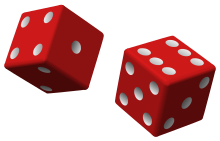
A random number is generated by a random (stochastic) process such as throwing Dice. Individual numbers can't be predicted, but the likely result of generating a large quantity of numbers can be predicted by statistics.

A random number is generated by a random (stochastic) process such as throwing Dice. Individual numbers can't be predicted, but the likely result of generating a large quantity of numbers can be predicted by statistics.
Random numbers are frequently used in algorithms such as Knuth's 1964-developed algorithm [1] for shuffling lists. (popularly known as the Knuth shuffle or the Fisher–Yates shuffle , based on work they did in 1938).
In 1999, a new feature was added to the Pentium III: a hardware-based random number generator. [2] [3] It has been described as "several oscillators combine their outputs and that odd waveform is sampled asynchronously." [4] These numbers, however, were only 32 bit, at a time when export controls were on 56 bits and higher, so they were not state of the art. [5]
In common understanding, "1 2 3 4 5" is not as random as "3 5 2 1 4" and certainly not as random as "47 88 1 32 41" but "we can't say authoritavely that the first sequence is not random ... it could have been generated by chance." [6]
When a police officer claims to have done a "random .. door-to-door" search, there is a certain expectation that members of a jury will have. [7] [8] [ example needed ]
Flaws in randomness have real-world consequences. [9] [10]
A 99.8% randomness was shown by researchers to negatively affect an estimated 27,000 customers of a large service [9] and that the problem was not limited to just that situation.[ clarification needed ]
In the computer science subfield of algorithmic information theory, a Chaitin constant or halting probability is a real number that, informally speaking, represents the probability that a randomly constructed program will halt. These numbers are formed from a construction due to Gregory Chaitin.

A hash function is any function that can be used to map data of arbitrary size to fixed-size values, though there are some hash functions that support variable length output. The values returned by a hash function are called hash values, hash codes, hash digests, digests, or simply hashes. The values are usually used to index a fixed-size table called a hash table. Use of a hash function to index a hash table is called hashing or scatter storage addressing.
A pseudorandom sequence of numbers is one that appears to be statistically random, despite having been produced by a completely deterministic and repeatable process. Simply put, the problem is that many of the sources of randomness available to humans rely on physical processes not readily available to computer programs.

The Pentium FDIV bug is a hardware bug affecting the floating-point unit (FPU) of the early Intel Pentium processors. Because of the bug, the processor would return incorrect binary floating point results when dividing certain pairs of high-precision numbers. The bug was discovered in 1994 by Thomas R. Nicely, a professor of mathematics at Lynchburg College. Missing values in a lookup table used by the FPU's floating-point division algorithm led to calculations acquiring small errors. While these errors would in most use-cases only occur rarely and result in small deviations from the correct output values, in certain circumstances the errors can occur frequently and lead to more significant deviations.
A pseudorandom number generator (PRNG), also known as a deterministic random bit generator (DRBG), is an algorithm for generating a sequence of numbers whose properties approximate the properties of sequences of random numbers. The PRNG-generated sequence is not truly random, because it is completely determined by an initial value, called the PRNG's seed. Although sequences that are closer to truly random can be generated using hardware random number generators, pseudorandom number generators are important in practice for their speed in number generation and their reproducibility.

A linear congruential generator (LCG) is an algorithm that yields a sequence of pseudo-randomized numbers calculated with a discontinuous piecewise linear equation. The method represents one of the oldest and best-known pseudorandom number generator algorithms. The theory behind them is relatively easy to understand, and they are easily implemented and fast, especially on computer hardware which can provide modular arithmetic by storage-bit truncation.
A cryptographically secure pseudorandom number generator (CSPRNG) or cryptographic pseudorandom number generator (CPRNG) is a pseudorandom number generator (PRNG) with properties that make it suitable for use in cryptography. It is also referred to as a cryptographic random number generator (CRNG).

In mathematics, the binary logarithm is the power to which the number 2 must be raised to obtain the value n. That is, for any real number x,

RANDU is a linear congruential pseudorandom number generator (LCG) of the Park–Miller type, which was used primarily in the 1960s and 1970s. It is defined by the recurrence:

In mathematics and computer science, the middle-square method is a method of generating pseudorandom numbers. In practice it is a highly flawed method for many practical purposes, since its period is usually very short and it has some severe weaknesses; repeated enough times, the middle-square method will either begin repeatedly generating the same number or cycle to a previous number in the sequence and loop indefinitely.
A random permutation is a random ordering of a set of objects, that is, a permutation-valued random variable. The use of random permutations is often fundamental to fields that use randomized algorithms such as coding theory, cryptography, and simulation. A good example of a random permutation is the shuffling of a deck of cards: this is ideally a random permutation of the 52 cards.

Vaughan Pratt is a Professor Emeritus at Stanford University, who was an early pioneer in the field of computer science. Since 1969, Pratt has made several contributions to foundational areas such as search algorithms, sorting algorithms, and primality testing. More recently, his research has focused on formal modeling of concurrent systems and Chu spaces.
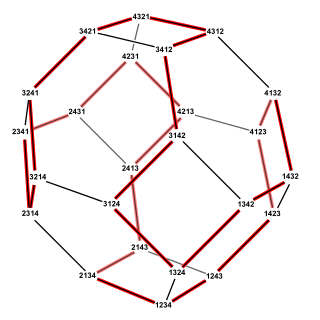
The Steinhaus–Johnson–Trotter algorithm or Johnson–Trotter algorithm, also called plain changes, is an algorithm named after Hugo Steinhaus, Selmer M. Johnson and Hale F. Trotter that generates all of the permutations of elements. Each two adjacent permutations in the resulting sequence differ by swapping two adjacent permuted elements. Equivalently, this algorithm finds a Hamiltonian cycle in the permutohedron, a polytope whose vertices represent permutations and whose edges represent swaps.
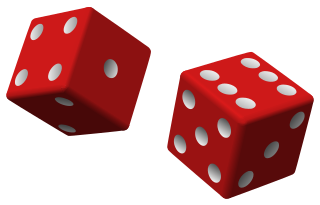
Random number generation is a process by which, often by means of a random number generator (RNG), a sequence of numbers or symbols that cannot be reasonably predicted better than by random chance is generated. This means that the particular outcome sequence will contain some patterns detectable in hindsight but impossible to foresee. True random number generators can be hardware random-number generators (HRNGs), wherein each generation is a function of the current value of a physical environment's attribute that is constantly changing in a manner that is practically impossible to model. This would be in contrast to so-called "random number generations" done by pseudorandom number generators (PRNGs), which generate numbers that only look random but are in fact pre-determined—these generations can be reproduced simply by knowing the state of the PRNG.
In computer science, the Fibonacci search technique is a method of searching a sorted array using a divide and conquer algorithm that narrows down possible locations with the aid of Fibonacci numbers. Compared to binary search where the sorted array is divided into two equal-sized parts, one of which is examined further, Fibonacci search divides the array into two parts that have sizes that are consecutive Fibonacci numbers. On average, this leads to about 4% more comparisons to be executed, but it has the advantage that one only needs addition and subtraction to calculate the indices of the accessed array elements, while classical binary search needs bit-shift, division or multiplication, operations that were less common at the time Fibonacci search was first published. Fibonacci search has an average- and worst-case complexity of O(log n).
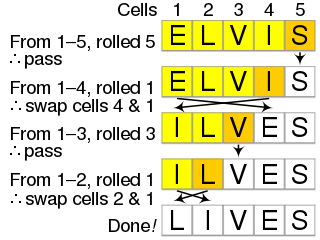
The Fisher–Yates shuffle is an algorithm for shuffling a finite sequence. The algorithm takes a list of all the elements of the sequence, and continually determines the next element in the shuffled sequence by randomly drawing an element from the list until no elements remain. The algorithm produces an unbiased permutation: every permutation is equally likely. The modern version of the algorithm takes time proportional to the number of items being shuffled and shuffles them in place.

In common usage, randomness is the apparent or actual lack of definite pattern or predictability in information. A random sequence of events, symbols or steps often has no order and does not follow an intelligible pattern or combination. Individual random events are, by definition, unpredictable, but if there is a known probability distribution, the frequency of different outcomes over repeated events is predictable. For example, when throwing two dice, the outcome of any particular roll is unpredictable, but a sum of 7 will tend to occur twice as often as 4. In this view, randomness is not haphazardness; it is a measure of uncertainty of an outcome. Randomness applies to concepts of chance, probability, and information entropy.
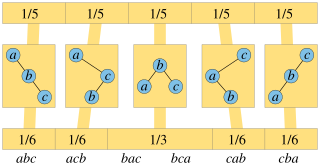
In computer science and probability theory, a random binary tree is a binary tree selected at random from some probability distribution on binary trees. Different distributions have been used, leading to different properties for these trees.
TestU01 is a software library, implemented in the ANSI C language, that offers a collection of utilities for the empirical randomness testing of random number generators (RNGs). The library was first introduced in 2007 by Pierre L’Ecuyer and Richard Simard of the Université de Montréal.